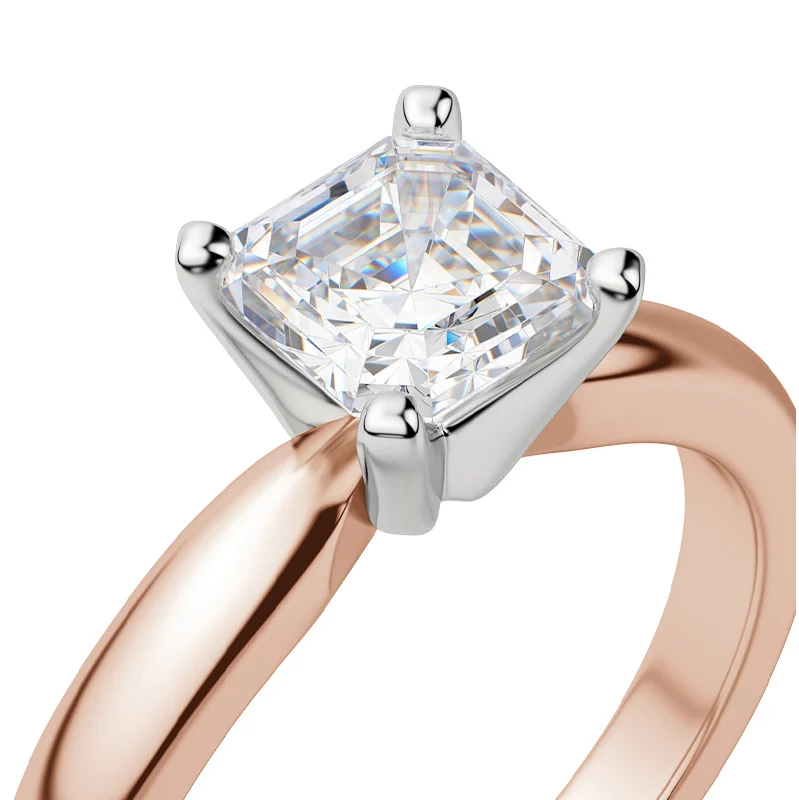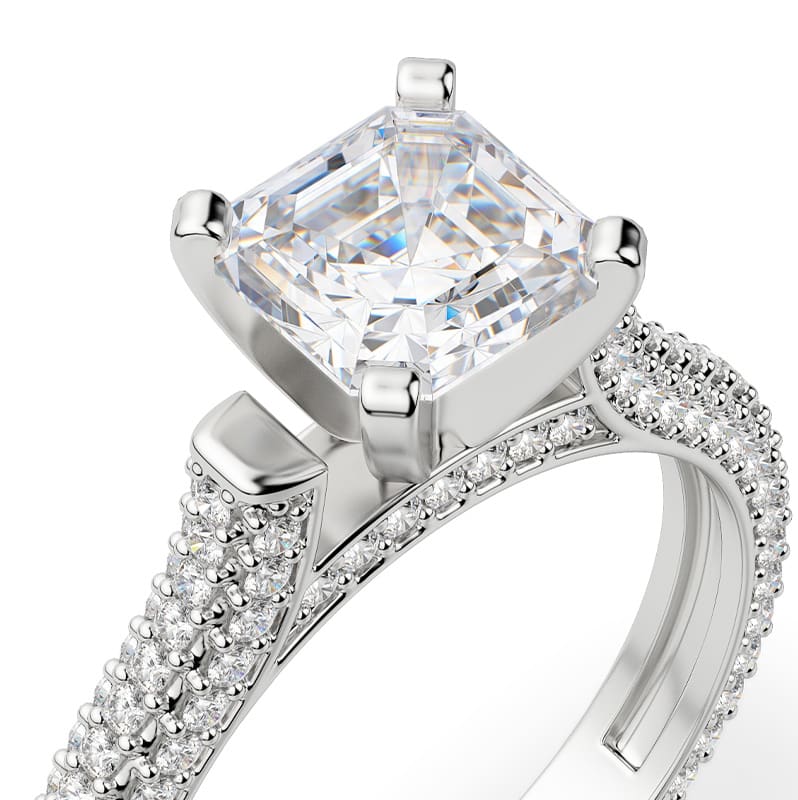What Is an Asscher Cut Diamond?
September 13th, 2021 / Alese Oldenburg
Distinct in style, Asscher cut diamonds are cropping up everywhere from vintage engagement ring designs to loose diamonds. But what exactly are Asscher cut diamonds and what makes them stand out from the diamond crowd?
Read on to discover the history, specs and engagement ring designs that best fit the bold Asscher cut diamond.
What Is an Asscher Cut Diamond?
The Asscher cut diamond was created by the Asscher Brothers of Holland’s Asscher Diamond Company (now the Royal Asscher Diamond Company) in the early 1900s. However, this unique geometric design didn’t find its true popularity until the 1920s.
 Similar in appearance to the dramatic emerald cut diamond, Asscher cut diamonds are square in shape and feature large step facets and a high crown. The result is layers of sparkle that are unlike that of any other diamond shape. To give you a better idea of this cut’s one-of-a-kind brilliance, diamond experts often refer to its shine and sparkle as an endless hall of mirrors.
Similar in appearance to the dramatic emerald cut diamond, Asscher cut diamonds are square in shape and feature large step facets and a high crown. The result is layers of sparkle that are unlike that of any other diamond shape. To give you a better idea of this cut’s one-of-a-kind brilliance, diamond experts often refer to its shine and sparkle as an endless hall of mirrors.
Another distinct feature of the Asscher cut is its cropped corners. While not noticeable once added to an engagement ring setting, Asscher cuts are technically a somewhat octagonal shape due to this feature.
History of the Asscher Cut
The original Asscher cut consisted of 58 facets and was never patented. In fact, the diamond shape was instead often referred to as “the square emerald cut” which caused some confusion in the fine jewelry world. Today, the term Asscher cut acts as an umbrella term when discussing square emerald shapes of which there are three – the Royal Asscher Cut with 74 facets, the modern square emerald cut and the original Asscher both with 58 facets respectively.
Asscher and emerald cut engagement rings are among the oldest of diamond shapes. Their simplistic nature in comparison to modern designs like the round brilliant cut and princess cut diamond requires less precision during the cutting process.
 Another interesting bit of history, the Asscher family was responsible for cutting some of the world’s largest and most important diamonds. According to gemsociety.org, “Possibly the most well-known of its prestigious diamonds would be the Cullinan, discovered in 1905, and weighing a whopping 3,106 carats. Found in S.(South) Africa, it was immediately presented to Britain’s King Edward VII. Much discussion went into considering how it would be cut and into how many individual stones. History now recounts that Joseph Asscher would eventually cleave the Cullinan into three parts, guided by inclusions within the stone. Nine large stones were eventually cut front hat one rough. The largest is the famed Cullinan I at 530.20 carats, which today is part of Great Britain’s Crown Jewels.”
Another interesting bit of history, the Asscher family was responsible for cutting some of the world’s largest and most important diamonds. According to gemsociety.org, “Possibly the most well-known of its prestigious diamonds would be the Cullinan, discovered in 1905, and weighing a whopping 3,106 carats. Found in S.(South) Africa, it was immediately presented to Britain’s King Edward VII. Much discussion went into considering how it would be cut and into how many individual stones. History now recounts that Joseph Asscher would eventually cleave the Cullinan into three parts, guided by inclusions within the stone. Nine large stones were eventually cut front hat one rough. The largest is the famed Cullinan I at 530.20 carats, which today is part of Great Britain’s Crown Jewels.”
What Makes an Asscher Cut Unique?
The original Asscher cut gives off a very distinct Old Hollywood feel. Featuring graphic lines and geometric forms, the Art Deco inspiration in this diamond cut is undeniable.
Rob Sutton said the following regarding Art Deco and its impact on the world in an article for Frank Darling, “It was the style of the flapper girl and the factory, the luxury ocean liner and the skyscraper, the fantasy world of Hollywood and the real world of the Harlem Renaissance. Art Deco affected all forms of design, from the fine and decorative arts to fashion, film, photography, transport, and product design. It was modern, and it was everywhere.”
The Asscher cut is truly special and is a great fit if you have your heart set on a vintage engagement ring. Pair an Asscher cut with a platinum or white gold setting to really pay homage to this epic era in U.S. history.
An Asscher cut engagement ring is also a great choice if you’re in the market for a step cut diamond. Alternative step cut stones include emerald and baguette cut diamonds.
When it comes to sparkle, Asscher cut diamonds do not disappoint. While different in appearance from the brilliance of a round, princess or even radiant cut stone, the steps in an Asscher cut diamond ring stone offer unparalleled dazzle when exposed to light.
Asscher Cut Diamond Rings
Clarity Grade 
Because the table of the stone is flat, Asscher cut diamonds offer an unobstructed view into the center of the stone. That means that stones in this style should have a higher clarity grade to prevent inclusions that are visible to the naked eye. If deciding between an asscher cut vs cushion cut, for example, you may opt for a lower clarity grade with a cushion cut. This is solely because the natural brilliance of a cushion cut can more easily conceal inclusions compared to an Asscher cut diamond. To ensure that your diamond is eye-clean and high-quality, aim for VS2 clarity or greater.
Diamond Color
The faceting in an Asscher cut makes it easier to see color than other diamond shapes on the market. This is especially true if your stone is larger than 1.5 to 2.0 on the diamond carat size chart. For the best results, many diamond experts recommend choosing a color grade that is I color or better.

Engagement Ring Settings
There are seemingly endless options when it comes to choosing a setting for your Asscher cut diamond engagement ring. However, a handful of designs will make your stone look like a cut above the rest.

Solitaire engagement ring settings are known for their ability to amplify a center stone’s beauty. Featuring a sleek metal band in your choice of rose gold, yellow gold or white gold, rings in this style are simplistic and no-frills. But what isn’t simplistic in the slightest is how magical your Asscher cut diamond will look when it takes center stage in this minimalistic design.

If you enjoy the uncomplicated approach of the solitaire engagement ring setting but are looking for just a little more sparkle, a pave setting might be the right choice for you. In this style, several accent stones or diamonds line the ring’s band adding some much-welcomed dazzle to the overall design. What’s more, this added shimmer will only enhance the natural beauty of your center stone.

For an unapologetically glam style, you simply cannot beat a halo engagement ring setting. Halo settings feature a handful of accent stones that encircle the center stone, thus creating a “halo” effect that is nothing short of breathtaking. Top it off with a solitaire band to let the center stone do all the talking or add an accented wedding band for even more sparkle. The choice is yours.
Sources
https://www.gemsociety.org/article/history-asscher-cut-diamonds/
https://www.brilliance.com/diamonds/what-is-an-asscher-cut-diamond
*Here at Diamond Nexus, we strive to provide valuable information while being clear and honest about our products. The Nexus Diamond™ alternative is a patented lab created diamond simulate that, among all simulants, most closely imitates the look, weight and wear of a diamond, with two exceptions – it is absolutely perfect in every way, and it costs significantly less. Price points and environmental facts expressed in this blog were taken from popular online retailers and may vary. Learn more about the environmental impact of mining by visiting our blog.

